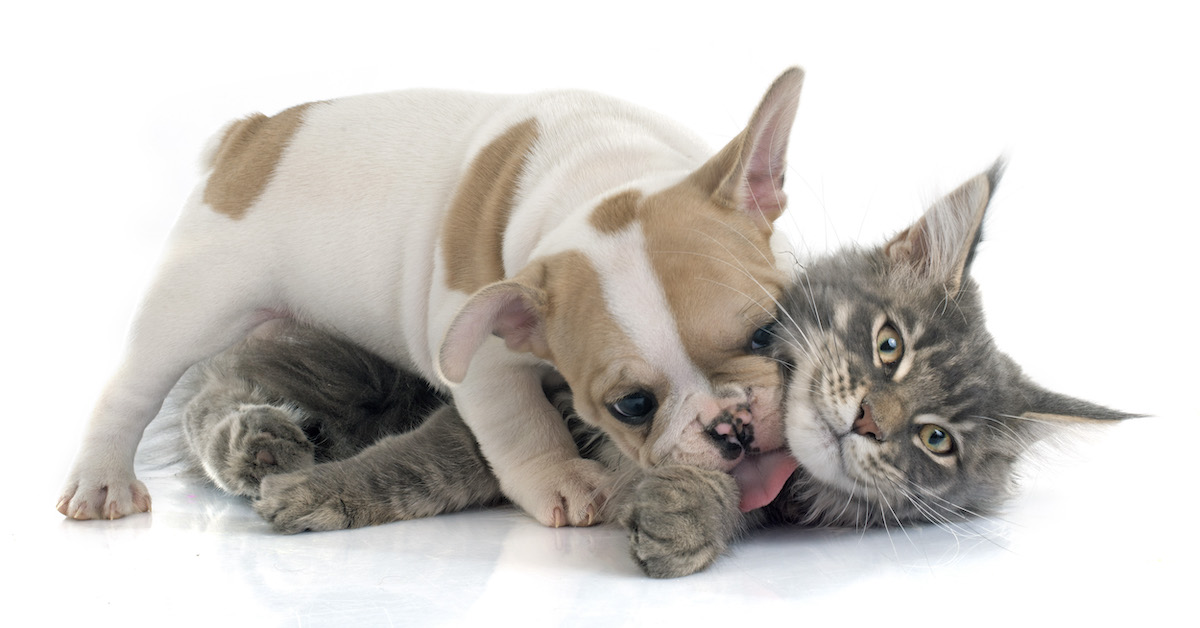Guide to Helping Cats and Dogs Get Along
When you take the time for proper introductions and consistent training, you can teach your cat and dog to get along.

Most people believe that cats and dogs are natural enemies. While there are plenty of cats and dogs that don’t get along, pets of different species can be taught to happily coexist. In fact, many households that have both cats and dogs have proven that these very different animals can actually become best friends.
Whether you plan to raise a cat and dog together from a young age or are introducing them as adults, there are certain precautions you’ll want to take to keep them both safe. Consider the following tips and recommendations for helping cats and dogs get along.
The Complicated Cat-Dog Relationship
The rivalry between cats and dogs has long been documented in films, TV shows, and other forms of media. Although there are many homes in which cats and dogs live in harmony, the truth is that these species instinctually don’t get along. This hostility is primarily due to behavioral differences.
Cats and dogs differ significantly in their personalities and behaviors. Dogs are known to be more friendly and will often approach a person or another animal in an excitable way which can be off-putting to cats. Felines, on the other hand, tend to approach people and other animals slowly and more cautiously.
While each animal is unique, cats tend to be more independent and often prefer isolation. However, dogs are descended from pack animals and enjoy being in the company of others. Although your dog may want to enjoy cuddles, your cat may prefer her own space.
Cats will often see dogs as threats as canines have a natural instinct to chase smaller animals that flee. In turn, a cat may hiss, swipe at the dog, or arch its back as a way to frighten the dog away. This can cause some dogs to become fearful of cats and cats to be threatened by dogs.
Tips for Helping Cats and Dogs Get Along
1. Start as Early as Possible
It is generally much easier for cats and dogs to get along if they are raised together. Ideally, you want to introduce your dog to your cat when he is still a young puppy. Puppies are more easily trained than adult dogs and tend to be less confident. This means that a puppy is more likely to allow a cat in the house to assume the alpha position which tends to be the most effective arrangement in dog and cat households.
2. Consider Breed and Personality
Several aspects come into play when determining whether or not a cat and dog will get along. Breed and personality are both key factors to take into account. For example, a household with an elderly dog may not be a good fit for a rambunctious kitten. Also, consider if your dog is territorial or has aggressive tendencies as this could affect your decision to bring a cat into the home.
3. Create Familiarity with Scent
Smell is one of an animal’s most used senses. Both cats and dogs use smell to get to know another animal and this can be useful when helping cats and dogs get along. Before bringing home your new pet, give the pet currently in your home a blanket that smells like the new pet. This will help your current pet get used to the scent before the cat and dog actually meet.
4. Provide Separate Territories
While both cats and dogs can learn to enjoy each other’s company, it is still important that they have their own areas where they feel safe and comfortable. For dogs, this could be a crate or a dog bed. For cats, this should be a location that is not accessible by a dog, such as a cat scratch tree or another platform that your cat can climb and jump to access.
5. Focus on Obedience Training
One of the biggest problems that pet owners run into when introducing their cat and dog to one another is chaos. The dog often wants to chase the cat and the cat becomes defensive and attempts to hide or swipe at the dog. These types of behavior can lead to ill feelings towards one another. Dogs must be trained to obey basic commands to keep unwanted behavior under control.
6. Treat Your Pets as Equals
Just like human siblings, pet siblings can become jealous of one another, resulting in a buildup of resentment. To help curb these types of emotions, it’s important to treat your pets as equals, meaning divide the amount of treats, toys, and attention you give to both your cat and dog equally. Also, keep their possessions separated to avoid problems like food aggression.
7. Seek Out Professional Help
In some cases, no matter what you do to get your cat and dog to get along, nothing you do will work. When this happens, it’s time to call in the professionals. A professional trainer or animal behaviorist can often help pet owners resolve conflicts between cats and dogs. In addition, your veterinarian may be able to provide advice or even prescribe certain medications, such as calming supplements, to help your pets get along.
Getting a cat and dog to get along can sometimes be a long and time-consuming process. However, if you want both animals to reside in your home in harmony, this is an essential process. Continue to closely supervise your pets until you are confident that they are getting along. In the end, your commitment to this important cause will be well worth it.
Ready to start saving money on pet wellness care?
Then take a look at Mint Wellness, the pet wellness plan that provides fast reimbursement on routine pet care. Save on vaccinations, wellness exams, preventatives, dental, and more!
Learn More


